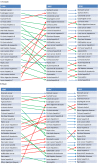Trend of Gastrointestinal and Liver Diseases in Iran: Results of the Global Burden of Disease Study, 2010
- PMID: 26396715
- PMCID: PMC4560627
Trend of Gastrointestinal and Liver Diseases in Iran: Results of the Global Burden of Disease Study, 2010
Abstract
BACKGROUND The general pattern of epidemiologic transition from communicable to noncommunicable diseases is also observed for gastrointestinal and liver diseases (GILD), which constitute a heterogeneous array of causes of death and disability. We aimed to describe the trend of GILD in Iran based on the global burden of disease (GBD2010) study from 1990 to 2010. METHODS The trend of number of deaths, disability, adjusted life years (DALYs) and their age-standardized rates caused by 5 major GILD have been reported. The change in the rankings of major causes of death and DALY has been described as well. RESULTS The age standardized rates of death and DALYs in both sexes have decreased from 1990 to 2010 for most GILD. The most prominent decreases in death rates are observed for diarrheal diseases, gastritis and duodenitis, and peptic ulcer disease. Positive trends are observed for liver cancer, pancreatic cancer, and gall bladder cancer. Diarrheal diseases have retained their 1st rank among children under 5. Among adults, decreased ranks are observed for diarrheal diseases, appendicitis, gastritis and duodenitis, gall bladder diseases, pancreatitis, and all types of cirrhosis. The trends in age standardized rates of DALYs, deaths, and YLLs are negative for almost all GILD, and especially for diarrheal diseases. However, there is no upward or downward trend in rates of years lost due to disability (YLDs) for most diseases. Total numbers of DALYs and deaths due to acute hepatitis C, stomach cancer, and liver cancers are rising. The total DALYs due to overall digestive diseases except cirrhosis and DALYs due to cirrhosis are both somehow stable. No data has been reported for GILD that are mainly diagnosed in outpatient settings, including gastroesophageal reflux disease, irritable bowel syndrome, and non-alcoholic fatty liver disease. CONCLUSION The results of GBD 2010 demonstrate that the rates of most GILD are decreasing in Iran but total DALYs are somehow stable. However, as diseases detected in outpatient settings have not been captured, the burden of GILD seems to be underestimated. Population-based studies at national level are required for accurate reports.
Keywords: Burden; Disability; Gastrointestinal Diseases; Mortality.
Figures
References
-
- De Maeseneer J, Roberts RG, Demarzo M, Heath I, Sewankambo N. et al. Tackling NCDs: a different approach is needed. Lancet. 2012;379:1860–1. - PubMed
-
- Global Status Report on Noncommunicable Diseases. Geneva.World Health Organization. 2011.
-
- Preventing Chronic Diseases: A Vital Investment: WHO Global Report.World Health Organization, Geneva. 2005.
-
- Murray CJ, Vos T, Lozano R, Naghavi M, Flaxman AD, Michaud C. et al. Disability-adjusted life years (DALYs) for 291 diseases and injuries in 21 regions, 1990-2010: a systematic analysis for the Global Burden of Disease Study 2010. Lancet. 2012;380:2197–223. - PubMed
LinkOut - more resources
Full Text Sources










